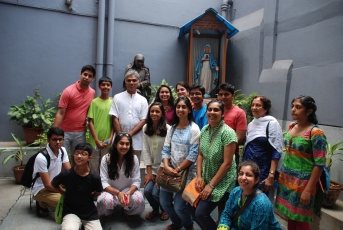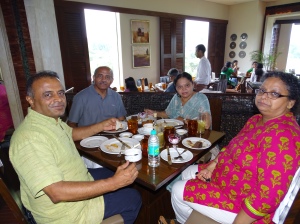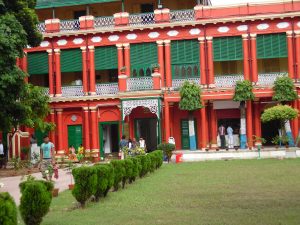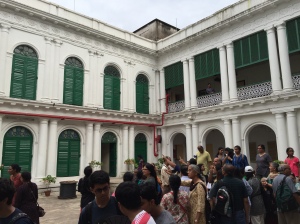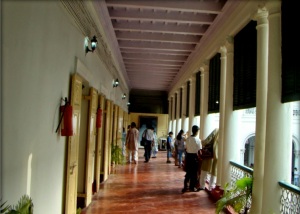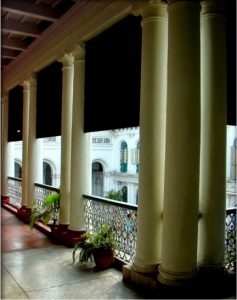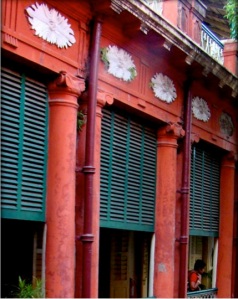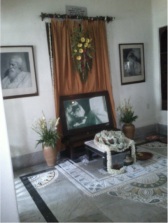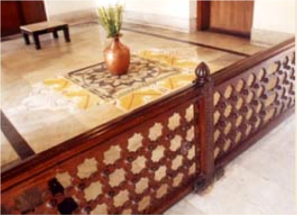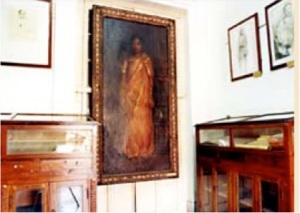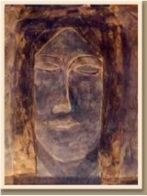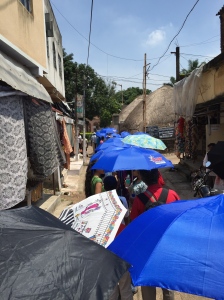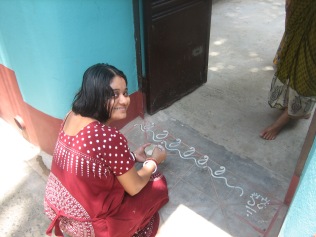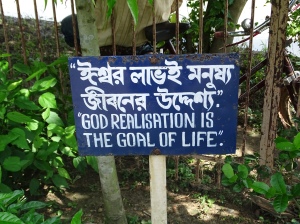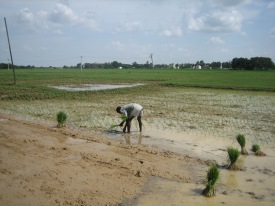August 7, 2015
Going to Baranagore Math
On Friday, all the pilgrims woke up around 5:30 am, got ready and went downstairs for a lovely breakfast at the Gucchi. Breakfast consisted of a vast array of foods from “dosas” to cereals. Over the breakfast table, everyone was happily talking about the inspiring pilgrimage they had experience thus far. With the grace of Mother Nature and God, we had nice weather and were able to carry out the pilgrimage without many problems. After having a good breakfast everyone gathered at the entrance of the Hyatt Hotel, ready to board our buses. After getting onto buses according to our groups, the buses left around 7am. Today, we had planned to visit the Baranagore Math and the Cossipore Garden House in the morning, and after lunch we were going to visit Jorasanko. While coming back from Jorasanko we had planned a bus tour of Kolkata. Everyone was excited about the scheduled program.
As usual in each bus, after “five Jai’s” everyone did the Morning Prayer including the “Sri Ramakrishna Suprabhatam.”
After about an hour, we arrived at the Baranagore Math. It was a bright morning.






As we entered the Math, we saw two pillars on the two sides of the gate.





We were told that these were the last of the remaining historic pillars from the old Baranagore Math building. As we entered, we were told to go upstairs to the shrine room to offer our salutations.
We placed our shoes on a rack, went upstairs, and quietly sat in the prayer hall.


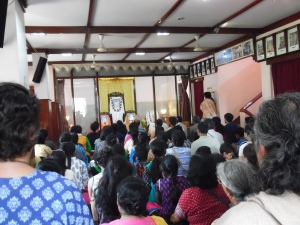

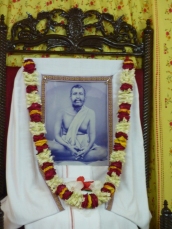



The environment was very serene. We were thinking of Sri Ramakrishna’s young disciples who had observed intense spiritual practices in this Math. It was this important period that established the foundation of the Ramakrishna Math and Mission. We were very happy to learn that it was Shri Nag Mahashay’s birthday on the day of our visit. Shri Nag Mahashay was a great household devotee of Sri Ramakrishna. He was a living example of a householder who had absolutely no ego. He had inspired many people, and all the disciples of Sri Ramakrishna had great reverence for him.
After our salutations, we recited the pranam manras, offering our salutations to Sri Ramakrishna, Holy Mother Sri Sarada Devi and Swami Vivekananda. Then we sang “Jaya Vireshwara Vivekabhaskar..,” as an offering to Swami Vivekananda. After singing, we spent a few minutes doing japa.
Around the perimeter of the prayer hall, there were photographs of all the original disciples and the original Baranagore Math as well as quotes of Swami Vivekananda .



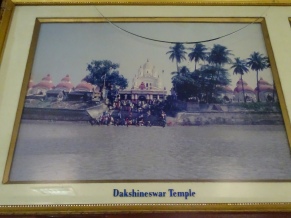





While looking at all the pictures, we thought of the disciples’ days at the Baranagore Monastery. We were given some Prasad. After looking all the pictures, we came downstairs and went into the backyard.

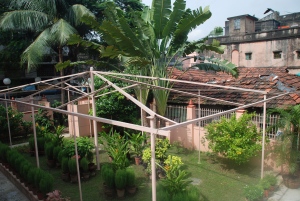


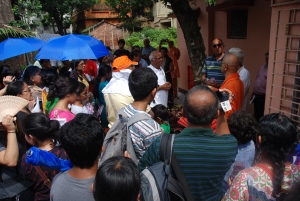




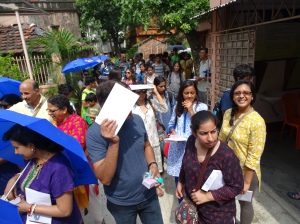

Swami Snehamayananda pointed to the grounds that marked the location of the original Baranagore Math. We took in the sight of the old grounds, paid our respects, and enjoyed the beautiful garden. The weather was great and environment was serene and peaceful. It filled our minds and hearts with joy and uplifting power. We were given refreshments arranged by the Swamis of the Math.


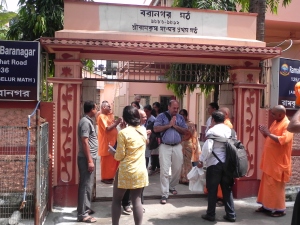

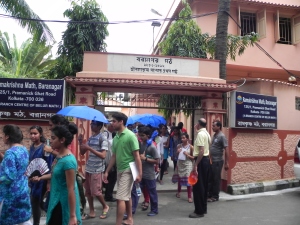
We were greeted by three Swamis, Swami Bamanananda, Secretary Maharaj, Swami Snehamayananda and Swami Devatattowananda, who were very happy to see all of us. As we prepared to leave, they lovingly stood at the gates to see us off. Before boarding our buses, we saluted the Swamis and took their blessings. As we sat on the bus, we remembered the hardships and austerities of the direct disciples of Sri Ramakrishna. Soon we were off to another important place, the Cossipore Garden House, where Sri Ramakrishna spent his last eight months.

The following information and incidents show us the real importance of the Baranagore Math. They truly inspire us to better ourselves in our spiritual path.
Baranagore Math:
The Baranagore Math was established in October 1886 and then the Math was moved to the Alambazar Math in February 1892. The Baranagore Math is a very important place for the Ramakrishna Math and Mission and for its activities. It was the first headquarter for the monks of the Ramakrishna Order.
Sri Ramakrishna passed away on August 16, 1886 at the Cossipore Garden House. Several youngsters had given up their homes and studies to serve their Master (Sri Ramakrishna). Tarak, Latu, and Elder Gopal (Budho Gopal) had renounced their homes and family-life. After Sri Ramakrishna passed away, most of the youngsters had to go home because the lease of the Cossipore Garden house was ending in August. Narendra was worried about the spiritual future of all the youngsters, including him. Sri Ramakrishna had told him to take care of his young disciples and to make sure that their spiritual urge to realize God and to serve humanity continued.
One evening, early in September 1886, while Surendra Mitra was meditating in front of his shrine, he had a vision of Sri Ramakrishna who told him, “What are you doing here? My boys are roaming about without a place to live. Attend to that before anything else.” Immediately, Surendra rushed to Narendra’s house and asked him and other young disciples to rent a house. Surendra said that he would pay the rent of the house.

Narendra and the other disciples rented a house in Baranagore at eleven rupees per month. This was the first Ramakrishna monastery. Tarak, Kali, Shashi, and Elder Gopal lived in the Baranagore Math. Narendra used to come in the evening, and other disciples visited whenever they could.
The Baranagore Monastery was an abandoned, dilapidated two-story building, infested with snakes and said to be haunted by ghosts. The rooms on the ground floor were dark, damp, and unfit for habitation, so they were used as kitchen and for storage. Shashi was once bitten by a snake in one of those dark rooms.

The monks set up a shrine in an upstairs room. The relics of the Master were brought from Balaram’s house, and a picture of Sri Ramakrishna was placed on the altar. The articles that the Master had used at Cossipore were also preserved in the shrine room. Shashi kept the memory of the Master ablaze in the Monastery with his wholehearted dedication and devout service to the Master. His scrupulous precision and regularity of service made everybody feel the living presence of the Master.
Narendra devoted himself–heart and soul–to the training of the young brother disciples. He spent the daytime at home, supervising a lawsuit that was pending in court and looked after other family affairs. Since his father had passed away, he was responsible for taking care of his mother and siblings. During evenings and nights, he was always with his brother disciples at the monastery, encouraging them to practice spiritual disciplines. His presence at the monastery was a source of unfailing delight and inspiration to all.
The following incident played an important role in shaping the future of the young disciples.
Antapur Incident:
Baburam’s mother, Matangini Devi, invited–through her eldest son Tulsiram–all the youngsters to her house in Antpur towards the end of December. Narendra and the other youngsters decided to go to Antpur. From Howrah nine youngsters, namely, Narendra, Baburam, Sarat, Shashi, Tarak, Kali, Niranjan, Gangadhar and Saradacharan, boarded a train going to Tarkeshwar. They had a tanpura and tabla with them. In the train they sang “Shiva Shankar Bum Bum Bhola” and other songs. They got off the train at the Haripal station and with horse carriages travelled eight miles to Antpur. Matangini Devi was extremely happy to receive them and made all arrangements for their stay and meals.
In the quiet and green natural surroundings, they all spent their time singing bhajans, doing prayer, japa, and meditation, discussing the teachings of Sri Ramakrishna, and remembering his infinite love.
One day, all the youngsters were discussing spirituality until late in the evening under the open bright starlit sky. Upon Narendra’s suggestion, they lit a “dhoony” (a friendly fire) which Sadhus (renounced people) light before meditation. Around the fire, they meditated for a while. At that time, Narendra was inspired to talk about the life of Jesus Christ and about his penances and sacrifices. His moving speech was filled with the fire of renunciation; it touched everyone’s hearts. He then talked about the sacrifices made by St. Paul and other disciples of Jesus Christ. Narendra concluded his speech saying that they had learned so much from their Master. Following the Master’s teachings, they must renounce the world for God realization and the service to humanity. Narendra’s speech infused everoyone’s spirit with burning renunciation. They all touched the fire and took a solemn vow to renounce the world for the goal of “God-realization and service to humanity.” As they took their vow in front of the fire, their faces glowed even brighter. When their minds came down to a normal plane, they were astonished to realize that it was “Christmas eve”.
Later recalling the incident Swami Shivananda said, “It was at Antpur that our resolve to become a group grew more intense.”
If we look into the lives of great personalities, we find that they have built the foundation for their lives’ goals from a young age. These youngsters also prepared themselves for the great, positive, historical, and everlasting impact they had left in the world. In 1886 Narendra’s age was 23, Kali was 20, Sarat and Sarada Prasanna were 21, Gangadhar was 22, Shashi was 23, Niranjan was 24, Baburam was 25 and Tarak was 32.
After spending a week in Antpur, all the brother disciples came back to Kolkata. In 1887 Rakhal and Elder Gopal went to Antpur with Narendra. In January 1887 at the Baranagore Math, these eleven people (10 youngsters and Elder Gopal) took “Sanyas” (renouncing the world for God-realization and service to humanity) by performing the “Viraja Homa.”
Monastic Names of Sri Ramakrishna’s Disciples:
With the “Viraja Homa” completed, all of the disciples of Sri Ramakrishna renounced everything and took monastic names. Narendra took the name Swami Vividishananda. During his pilgrimages to different places in India, he assumed the name Swami Satchidananda. It was before going to America, that he assumed the name Swami Vivekananda, upon the request of Raja Ajit Singh of Khetri.
The other disciples took the following names:
Rakhal….Swami Brahmananda Hari……Swami Turiyananda
Jogin……Swami Yogananda Sarat…..Swami Saradananda
Niranjan…..Swami Niranjanananda Shashi….Swami Ramakrishnananda
Latu……Swami Adbhutananda Kali…….Swami Abhedananda
Baburam…..Swami Premananda Gangadhar….Swami Akhandananda
Tarak……Swami Shivananda Elder Gopal….Swami Advaitananda
Sarada Prasanna…Swami Trigunatitananda Subodh……Swami Subodhananda
Life at Baranagore Math:
The young brother disciples lived an intense austere life at the Baranagore math. They spent day and night in japa, meditation, worship, studying scriptures, and devotional music. They used to forget to eat their meals. At such times, Shashi, who had constituted himself as their caretaker, literally dragged them to the dining room. Often, there was no food at all in the monastery. At that time without complaining, they would simply spend their time in prayer and meditation. They lived for months on boiled rice, salt, and bitter herbs. Sometimes they had only rice and no salt at all. But, no one cared about these inconveniences. At night, they slept on straw mats spread on the hard floor.
Narendra studied with them. They would study world history and various philosophical systems. They had a library that contained about a hundred books. They discussed and compared the philosophies of Aristotle, Plato, Kant, Hegel, Shankaracharya, Ramanujacharya, Madhavacharya, Chaitanya, Nimbark, Buddha and many. They also studied the Upanishads, Bhagavad Gita, and the four yogas. They could reconcile many apparent contradictions in light of Sri Ramakrishna’s life and teachings. The dryness of the discussions was removed by devotional music. There were many light moments, sometimes indulging in innocent laughter. Among all these activities, Narendra kept reminding them that their goal was to have complete control of their lower nature and God realization.
Some of the household disciples of Sri Ramakrishna did not approve of the austerities of the young men. One of them teasingly asked whether they had realized God by renouncing their homes. At that Narendra said sharply, “What do you mean? Suppose we have not realized God; must then we go back to the life of senses and deprave our higher nature?”
Swami Vivekananda’s reminiscences of Baranagore Monastery:
“After the passing away of Sri Ramakrishna, we underwent a lot of religious practices at the Baranagore Math. We used to get up at 3:00 a.m. and after washing our faces etc. we would sit in the shrine and become absorbed in japa and meditation. What a strong spirit of dispassion we had in those days! We had no thought of even as to whether the world exists or not…There were days when the japa and meditation continued from morning till four and five in the afternoon. Ramakrishnananda waited and waited with our meals ready, till at last he would come and snatch us from our meditation by sheer force….There were days when the monastery was without a grain of food. If some rice was collected by begging, there was no salt to take it with! On some days there would be only rice and salt, but nobody cared for it in the least. We were then being carried away by a tidal wave of spiritual practices. Oh, we had those wonderful days!”
Description of Baranagore Math in “The Gospel of Sri Ramakrishna” by M:
“The members of the (Baranagar) Math called themselves the ‘danas’ or ‘daityas,’ which means the ‘ghosts’ and the ‘demons,’ the companions of Shiva. They took these names because their indifference to worldly pleasures and relationships….Narendra and other members of the Math often spent their evenings on the roof. There they devoted a great deal of their time to discussions of the teachings of Sri Ramakrishna, Shankaracharya, Ramanuja, and Jesus Christ, and of Hindu Philosophy, European Philosophy, the Vedas, the Puranas, and the Tantras.”
(I believe M. visited the monastery mainly in the evenings.)
Interesting Incidents at Baranagore Math:
(1) Swami Advaitananda (Elder Gopal Maharaj):
At the Baranagore Math, Swami Advaitananda helped his brother monks with household work and played the tabla when Swami Vivekananda sang.
Sometimes the young monks would tease him or make him subject of practical jokes. Most of the disciples slept in one large room as they did not have many rooms. One night when Advaitananda went to the bathroom, Akhanadananda replaced his pillow with a brick. When Advaitananda returned, he discovered his brick-pillow. He smiled and said to Akhanadananda: “Ganga (Akhanadananda), I know you have done this mischief. Brother, I shall use your precious gift tonight as my pillow.” Akhandananda was touched by these words. He immediately threw away the brick and brought back his pillow. With an apology, Akhandananda said, “Brother, you are a real monk – free from anger and ego.”
(2) Swami Abhedananda (Kali ‘Tapasvi’ Maharaj):
The southernmost room of the second floor was used for meditation and study. Kali secluded himself in this room for most of the day and that is why this room was known as ‘Kali Tapasvi’s Room.’ ‘Tapasvi’ means one who performs severe austerities. He was an ascetic by nature. He ate vegetarian food, did not wear shoes, and shunned the company of people. He spent his time in meditation, studying scriptures and composing hymns on Sri Ramakrishna and Holy Mother.
He composed the famous hymn of Holy Mother, namely “Prakrutim Paramambhayam Varadam…” One day Kali visited Holy Mother at her residence at Nilambar Babu’s house in Belur and read this hymn to Holy Mother. After listening this hymn, Holy Mother blessed him saying, “May, Saraswati, the goddess of knowledge, reside on your tongue.”
When someone in the Baranagore Monastery complained that Kali was not taking any responsibility for the household work, Vivekananda said, “Let one of the brothers be a scholar and I will do the dishes myself.”
One day, Mahendranath Datta, one of Vivekananda’s brothers, was shocked when he saw Kali lying like a dead person in the sun on the dusty floor of the veranda. Jogin told him with a smile, “He is not dead. The rascal meditates that way.” The young disciples used to tease and make fun of each other. Ramakrishna gave a taste of true spirituality to these young disciples and made their spiritual practices filled with joy. Poverty and hardship could not dampen their spirit.
The brother disciples had deep love for each other. One night, Kali was shivering with cold and could not sleep; none of them had warm clothing or sufficient blankets. They were sleeping on the floor of a large room under a single mosquito net. When Kali told Narendra about his suffering, Narendra got up at 2:00 a.m. and made hot tea for his brother. He told Kali, “Enjoy this hot cup of tea and get rid of the cold.” He also teased Kali saying, “This hot cup of tea seems to me more concrete than your blessed theory of Advaita, don’t you think so?”
Kali was well versed in both Eastern and Western philosophies and enjoyed discussions with Narendra.
(3) Swami Adbhutananda (Latu Maharaj):
Latu Maharaj’s story is one of the miracles stories of Sri Ramakrishna. Latu was a servant of Ramachandra Datta. Sri Ramakrishna saw him when Latu came for some work. Sri Ramakrishna liked him and asked Ramachandra to keep him at Dakshineswar. Ramachandra agreed to it. Sri Ramakrishna made Latu a saint out of a servant. That is why Swami Vivekananda suggested the name Swami Adbhutananda for him. “Adbhuta” means wonder of wonders.
When Latu Maharaj came to the Baranagore Monastery some disciples had already taken monastic vows. Narendra Asked Latu Maharaj to do the same. Latu Maharj agreed immediately. During the “Sanyas ceremony” Latu Maharaj offered his own unconventional simple prayers instead of Sanskrit mantras. After he became Sanyasi, he stayed at the Baranagore Monastery for a year and a half. In later years he told many stories about the early days at the monastery.
Love of brother disciples:
Latu Maharaj said, “Shashi’s performance of the vesper service was something worth seeing. Everyone could palpably feel the Master’s presence….In those days we loved each other so dearly that if perchance someone got angry with someone else, that anger did not last long. Very often our topic of conversation would be the Master’s transcendent love. If one person said, “He used to love me most,” another would contradict him and say, “No, he loved me most.” One day during such a discussion I told them: ‘The Master did not leave any property behind and still your squabbling seems unending. The Lord alone knows whether you would have gone to court if he had left any property.’ There was outburst laughter at my remark.”
Why study scriptures?
Latu Maharaj said, “I noticed that everyone at the (Baranagore) Math was studying hard. One day I asked Brother Sharat (Swami Saradananda): ‘Why do you read so many books? All of you are finished with school, yet you study so hard! Are you to appear for an examination?’ Sharat replied, ‘Brother, without serious study how are we to understand the subtle matters of religion?’ I rejoined that the Master had talked so much about these subtle matters, and I had never seen him reading books. Sharat said: ‘His case was completely different. He himself said that the Divine Mother used to provide him with heaps of knowledge. Have we reached that stage, or can we hope to reach it? We have to read in order to acquire such knowledge.’
I (Latu Maharaj) did not leave the matter there, but replied, ‘The Master said that we get one conception of the truth through studying books and quite another by spiritual experience.’ Then Sharat said: ‘But didn’t he say that those who would be teachers will have to study the scriptures as well?’ Then I realized that men understand differently according to their mental constitutions and that the Master taught each one according to his own nature. From then on I kept quiet.”
Swami Ramakrishnananda on Latu Maharaj at Baranagore:
“We often had to call Latu back to normal consciousness and virtually force him to take food. There were many days when we called him again and again but no response, so we would place his food in his room and leave. The rest of the day passed. When we went to call him for supper, we would find the noon meal still there where it was placed, untouched and stale. We found Latu lying down in same straight posture as before, completely covered with a thick cotton chadar. We had to resort to many tricks just to force a little food down his throat.”
Swami Saradananda on Latu Maharaj at Baranagore:
Swami Saradananda jokingly said, “You see, at night that rascal Leto (Latu) dos not sleep at all. During the first part of the night he pretends to be asleep and even snores; but he keeps his rosary with him, and when the others are asleep he sits up and starts counting his beads (doing japa). One night I heard the ticking of beads and thought a mouse might have come in the room. When I gave a rap the sound stopped. A little later the ticks began again. This went on for a while, and I began to suspect that it might not be a mouse. The next night I stayed awake and was very watchful. The moment I heard the first tick, I struck a match and found Leto sitting up, counting his beads. Then I laughed: ‘Ah, you mean to surpass us all! While we are sleeping you are counting your beads!’”
Swami Turiyananda on Latu Maharaj at Baranagore:
Swami Turiyananda said, “Many of the brother monks were leaving the monastery at Baranagore to practice austerity. I too felt an urge to meet holy men in other places of India. As I was thinking this over, a voice said from within me, ‘Where will you find such a sadhu as he (meaning latu)?’ Startled, I turned my gaze and saw Latu Maharaj lying down covered with a thick cloth, deep in meditation….The very same moment Latu Maharaj spoke out: ‘Where will you go? It is better to engage yourself in tapasya (austerity) here.’ That time I stayed at the monastery.”
(4) Swami Turiyananda (Hari Maharaj):
At the Baranagore math, after taking the monastic vows Swami Vivekananda read and explain to his brother disciples two chapters from the Brihadaranyaka Upanishad, namely Antaryami Brahman 3.7 and Maitreyi Brahman 4.5. In these chapters renunciation and the greatest truths of Vedanta are discussed. They all plunged into achieving the highest goal of human life, realizing the Supreme.
After joining the monastery Swami Turiyananda passed through a dry spell. He described it later on: “When I was young and living in the Baranagore math, once I had a very despondent mood. I could not meditate. I was then pacing back and forth on the roof. Then suddenly there was a rift in the cloud, and out came the full moon in all its majesty. All darknesswas dispelled, and the whole landscape was flooded with light. As soon as I saw that I thought: ‘See, the moon was there all the time but I could not see it. So the Atman is also ever present, shining in its own glory, but I did not see it. The cloud of ignorance stood between the Atman and me. My intellect overshadowed my mind. And at once I felt strong again, my doubts were all gone.’”
In 1889 Swami Turiyananda left the Baranagore Math and went to Rishikesh and in summer of 1890 he went to Gangotri with Swami Saradananda.
(5) Swami Saradananda (Sharat maharaj):
After Sri Ramakrishna’s passing away on August 16, 1886, Sharat returned to his home. Sharat’s parents were happy to have him back, but his mind was not at peace. He could not concentrate his mind in his studies. Every now and then the blissful form of his Master would appear to him and he would cry.
When the Baranagore Monastery was established, Sharat started visiting it whenever he got a chance. Sometimes he stayed overnight at the monastery. Sharat’s father was alarmed that he would quit his studies and would go to the monastery, so he locked Sharat in a room. Sharat was waiting for the right moment. One day his brother Prakash unlocked the room and Sharat quietly walked out of the house and went to the monastery and stayed there. Later when Sharat’s parents found that their son was determined to dedicate his life to realize God and service to humanity, they went to the monastery and gave their blessings to him.
After the “Viraja Homa,” Swami Vivekananda gave the name Swami Saradananda to Sharat. At the Baranagore Math, Sharat Maharaj became absorbed in spiritual discipline. Sometimes Vivekananda and Saradananda would go to the Cossipore cremation ground where the Master’s body was cremated and spend the whole night in japam and meditation. Sometimes, they used to go to Dakshineswar and meditate at the Panchavati Grove. On April 9, 1887 Vivekananda said to M.: “The Master has given me charge of Sharat. He is now yearning for God. His kundalini has been awakened.”
At the monastery, Saradananda used to help with the household duties like cleaning the rooms, washing dishes, and so on. Saradananda learned from Vivekananda how to sing and play tabla. He had a sweet melodious voice, which from a distance could be mistaken to be a female voice. One night, while Saradananda was singing, some neighbors thought that a woman was singing. To find out what was going on, they scaled the wall and entered the monastery. After finding out that Swami Saradananda was singing they were ashamed of themselves and sincerely apologized to the monks. His singing and recitations of Chandi were very inspiring.
After Sri Ramakrishna’s birthday celebration, Saradananda went on a pilgrimage to Puri with Swami Premananda and Swami Abhedananda. When he returned to the monastery his body was emaciated but his face was a glow with devotion. He became more indrawn.
(6) Swami Premananda (Baburam maharaj):
Baburam’s mother had invited all young brother disciples to her house in Antpur. After the “Viraja Homa,” Swami Vivekananda gave the name Swami Premananda to Baburam Maharaj. Swami Vivekananda said that according to Sri Ramakrishna, a part of Srimati Radha had incarnated in Baburam since he was very pure and filled with unselfish love.
At the Baranagore Math, Premananda used to help with the household work as well as the Master’s worship. One day he fell from a tree while picking flowers for the master’s worship. He fractured his right wrist.
Later Premananda told a touching episode. He said, “After the passing away of Sri Ramakrishna Swami Vivekananda used to cry secretly at night remembering him. He used to cry so much that his pillow would get fully wet and I would put it in the sun in the morning to dry.”
During his stay at the monastery Premananda went on several pilgrimages with his brother disciples.
(7) Swami Brahmananda (Rakhal Maharaj):
After the “Viraja Homa,” Swami Vivekananda gave the name Swami Brahmananda to Rakhal Maharaj. Shortly after this, Rakhal Maharaj’s father went to the monastery to persuade him to return home. But, he calmly and firmly said to his father: “Why do you take so much trouble to come to me? I am quite happy here. Now bless me that I may forget you and you may forget me.”
At the Baranagore Math, Brahmananda became so absorbed in japa and meditation the he almost forgot the world.
In the Gospel of Sri Ramakrishna M. recorded his conversation with Rakhal Maharaj in the Baranagore Monastery:
Rakhal (earnestly): “M., let us practice spiritual discipline. We have renounced home for good. When someone says, ‘you have not realized God by renouncing home; then why this fuss?’ Narendra gives a good retort. He says, ‘Because we could not attain Rama, must we live with Shyama and beget children?’ Ah! Every now and then Narendra says nice things.”
M.: “What you say is right. I see that you too have become restless for God.”
Rakhal: “M., how can I describe the state of my mind? Today, at noontime I felt great yearning for the Narmada (a holy river in Central India).
During his stay at the Baranagore Math, Brahmananda went on pilgrimages of places like Puri, Kamarpukur, Jayrambati, Varanasi, and Omkarnath situated on the bank of Narmada.
(8) Swami Shivananda (Tarak Maharaj):
Tarak Maharaj was one of the three youngesters who started staying in the Baranagore Monastery from the first day. After the “Viraja Homa,” looking at his Shiva-like nature, Swami Vivekananda gave the name Swami Shivananda to Tarak Maharaj.
Swami Shivananda remarked during their stay at the Baranagore Monastery: “We had so much deep love for each other (among the brother disciples) that we were ready to sacrifice our lives for each other.”
Swami Shivananda lived at Baranagore for about two and a half years, developing his own spiritual life and helping to consolidate the new monastery. He nursed monks who fell ill, and did household work, such as cutting vegetables for cooking, carrying water from the Ganga, sweeping and dusting the rooms, and even cleaning the toilets.
(9) Swami Trigunatitananda (Sarada Prasanna Maharaj):
When the Baranagore Math started, Sarada Prasanna started visiting his brother disciples at the Math. His parents strongly did not approve of these visits. When Narendra and other brother disciples decided to go to Antpur, he secretly sent a message of this trip to Sarada Prasanna. Sarada immediately left home and joined the group.
One day in Antpur, Sarada went to take bath in a pond. He did not know how to swim. Suddenly he slipped from a step and fell in deep water. Immediately Niranjan dove into the water and rescued him.
When they returned to the Baranagore Math, Sarada went with the brother disciples instead of going home. Sarada’s elder brother Binay secretly arranged a sacrificial ceremony to try to change the mind of Sarada. Twelve brahmins performed the ceremony for one month and twelve days. Binay had spent four thousand rupees for the ceremony. After the ceremony the brahmins said that it was not possible for them to change the mind of Sarada as his desire was very intense to realize God. Then, Binay went to the Baranagore Monatery and asked the brother disciples to send Sarada home, but the brother disciples refused to do that. They said let Sarada himself decide what he wants to do. Sarada became disgusted with all these attempts and he stopped visiting home completely.
With the “Viraja Homa,” Sarada took the monastic vows and Swami Vivekananda gave him the name Swami Trigunatitananda. Swami Vivekananda used to tease him saying that his name was too long, so he would call him “Tirgunatita.”
One day, Swami Vivekananda asked Saradananda to visit Navadwip, the birthplace of Sri Chaitanya, on foot. Saradananda immediately prepared to walk sixty miles to Navadwip without any money. Swamis Shivananda and Trigunatitananda found out about it and they went along with him.
An amusing incident happened. Trigunatita’s eating habits were unusual! Once he had stomach ache. Swami Brahmananda sent him to Dr. Bepin Ghosh, a cousin of Swami Premananda, for a treatment. The doctor was a devotee and knew Trigunatita very well. He wanted to serve him before proceeding for the examination. He asked Trigunatita, “Please tell me what you would like to eat?” Swami said, “Rasagoollas,” (an Indian sweet – cheese balls soaked in syrup). Dr. Ghosh offered him two rupees’ worth of “Rasagollas,” more than two dozen. Trigunatita ate them all. Then, Dr, Ghosh asked, “Please tell me your trouble for which you had come to me?” Trigunatita replied, “I have a stomach problem.” Dr. Ghosh was shocked and asked, “My goodness! Why then did you eat these rasagollas?” Swami said that he offered him with love, so he ate them. The doctor than gave a medicine. Swami Trigunatitananda had tremendous self-control. He could eat an enormous amount of food and he could also fast for few days at a stretch.
During his spiritual practices at the Baranagore Math, Trigunatita had a great desire to perform some tantric rituals at midnight on the cremation grounds. He knew Vivekananda would not give him permission to do this. One night, when all brother disciples slept, he prepared to leave for the cremation ground. To his utter astonishment, he heard Swami Vivekananda, “Where are you going?” Trigunatita stood speechless. Vivekananda said, “Sri Ramakrishna appeared to me and told me where you are going. You should not go there. Sri Ramakrishna had given us everything and it is sufficient to keep our minds on him.” This was the end of his desire to do any tantric ritual.
Another amusing and touchy incident happened. Trigunatita decided to repeat his mantra 24/7. His goal was, “God-realization or starve to death.” Swami Shivananda was concerned about him. He persuaded him to come out from his room. Trigunatita did come out, but he refused to eat as his repetition of mantras would stop. Shivananda found a way out. Shivananda touched him and repeated the mantras on his behalf while Trigunatita hurridly ate some food.
Trigunatota’s father was trying to bring him back home. Trigunatita refused and he went to Puri on a pilgrimage.
In the Gospel of Sri Ramakrishna, M. mentioned the state of Trigunatita’s mind when he was at the Baranagore Math. On May 7, 1887 he wrote: “Narendra was in charge of the members of the monastery. Sarada Prasanna had been practicing austere sadhana for the past few days. Once, Narendra had told him his desire to fast to death for the realization of God. During Narendra’s absence in Kolkata, Prasanna had left the monastery for an unknown destination.
Narendra (to M.): “You see what a lot of trouble I am in! Here, too, I am involved in a world of Maya. Who knows where this boy had gone?”
Prasanna had left a letter for Narendra. He had written: “I am going to Vrindavan on foot. It is very risky for me to live here. Here my mind is undergoing a change….The Master once told me, ‘Your people at home are apt to do anything; never trust them.’”
(10) Swami Ramakrishnananda (Shashi Maharaj):
After Sri Ramakrishna passed away, Shashi reluctantly went home. But as soon as Narendra and other disciples rented the Baranagore Math with the help of Surendranath Mitra, Shashi joined his brother disciples.
Shashi Maharaj’s Service to Sri Ramakrishna:
From 1886 to 1897 Shashi kept a constant vigil over the Master’s relics, seldom visiting any holy place or leaving the monastery overnight. Because he came from an orthodox Brahmin family, he performed the Master’s worship as one serves a living human being. He would get up at 4:00 a.m., and after washing would enter the shrine to rouse the Master from his bed. He would then offer a twig for a toothbrush and water to rinse the mouth. Next he would offer some sweets made from coconut and a glass of water for breakfast. He never allowed his brother disciples to help him. Afterwards he would pick flowers, sweep the shrine, wash the worship vessels, and make the necessary preparations for the worship. He would then go to the nearby market to buy groceries. Shashi always bought the best product for the Master; although he did not have much money, he had a rich heart. After returning from the market he would help the cook cut vegetables, and then he would go to bathe in the Ganga and bring holy water for worship. Afterwards he would perform rituals and offer cooked food to the Master.
In the evening, he would conduct the vesper service, waving a light, fanning the Master, and singing with the disciples the vesper song of Vishwanath in Varanasi:
Jai Shiva Omkara, Bhaj Shiva Omkara,
Brahma Vishnu Sadashiva
Hara Hara Hara Mahadev!
Swami Virajananda’s (Swami Vivekananda’s disciple) reminiscences of arati:
“Oh, how wonderful was the ararti of Shashi Maharaj! It was really a sight for the gods. Enveloped within the dhooni of the incense and drowned in the music of drums and cymbals, he would wave a chamar (fanning to Sri Ramakrishna) towards the end of the arati. Intoxicated with God-consciousness he would repeat, “Jai Gurudev! Jai Gurudev!”, in a crescendo of divine abandon and would dance from one side of the hall to the other rhythmically pacing the floor. What a unique feeling of ecstatic love would course through the hearts of men witnessing it can better be imagined than described….The spectators would watch from the adjoining room and join him, all repeating in chorus, “Jai Gurudev! Jai Gurudev!”
After the Viraja Homa, Swami Vivekananda, knowing Shashi’s love for Sri Ramakrisha, gave him the name “Swami Ramakrishnananda.”.
Shashi Maharaj’s efforts to support the monastery:
To meet the expenses of the Baranagore Monastery, Shashi Maharaj worked as a teacher at the Baranagore High School for two hours daily after lunch, foregoing his rest. He continued this for three months to support the monastery.
Ramakrishnananda’s love:
One day four monks went out for alms, but unfortunately did not receive any food. The monastery store was empty. Ramakrishnananda was anxious and disturbed with the thought that the Master would have to starve that day. Giving up the desire for food, the brother disciples became absorbed in devotional singing. Ramakrishnananda then quietly went to the house of a friendly neighbor and said to him, “Brother dear, today nothing has been obtained from begging. Could you give me a handful of rice, some potatoes, and a little ghee?” Although other members of his family were not sympathetic, he gave a half a pound of rice, some potatoes, and little ghee. Ramakrishnananda gladly cooked that food and offered it to the Master. Then, he mixed it together and made small balls, which he carried to the hall and put one ball in the mouth of each brother disciple. That small amount of sanctified food appeased their hunger, and they were touched by Ramakrishnananda’s love and concern.
A heated exchange:
Swami Adbhutananda reminisced: “Once there was a heated exchange of words between brother disciples in connection with the shrine. It began when a household devotee said, “You fellows do nothing but act as priests to the photograph of the Master, burning incense and waving lights before it, just as orthodox priests do before the stone image of Goddess Shitala.”
This remark upset Brother Shashi very much and he said sharply: “The money of such a householder should not be touched with a barge pole! It is cursed.”
Brother Loren (Vivekananda) used to be amused when he saw Shashi angry. He told him, “All right, then go and beg food for your Master.” “Very well,” responded Shashi, “and I will not touch a bit of your money either! I will beg food in order to feed my Master.” Loren said with a smile, “And I suppose you will offer him luchis that you get by begging?” Undaunted Shashi replied, “Yes, I will offer him luchis; and moreover, I will serve those offered luchis to you to gulp down afterwards.”
Then Loren pretended to get angry: “No, by no means will I allow luchis to be offered to him while we have nothing to eat! Such a Master should be thrown out. If you won’t do it, I am going to throw him out myself!” Saying this, he sprang up and started towards the shrine. Shashi said something in English and ran after him.
When I saw what was happening, I tried to intercede. I told Loren, “Brother, why are you opposed to Shashi’s desire to serve luchis to the Master? Let him go his own way and you yours.” Loren returned, “Keep quiet, you fool.” A harsh retort was about to come out of my mouth, when Brother Loren laughed in such a way that Shashi too began to laugh. A few minutes later, we all were sitting together making arrangements for the Master’s worship.”
Shashi Maharaj’s sincerity in serving Sri Ramakrishna:
Swami Adbhutananda told this incident. “One day Brother Shashi asked an elderly Swami Satchidananda to put a fresh twig stripped of leaves and bark, in the shrine early in the morning to be offered to the Master for use as a toothbrush. The elderly swami did not know that one end of the twig was to be gently beaten to soften the fibers and make them like a brush….During the breakfast Shashi saw this, and he rushed to the elderly swami and scolded him saying, “You rogue, you have caused the Master’s gum bleed today. I will teach you a good lesson.” I cried out to the elderly swami, “Don’t just stand here looking at Shashi. Run away!” He fled and the situation calmed down immediately. Shashi got another twig, prepared it properly and threw away the old one.”
(11) Swami Niranjanananda (Niranjan Maharaj):
Niranjan took monastic vows after the “Viraja Homa” at the Baranagore Monastery. Swami Vivekananda gave him the name “Swami Niranjanananda.” he continued his spiritual discipline and austerities at the monastery.
Swami Niranjanananda helped performed the worship service and other household responsibilities. He thought that the altar for the Master must be better. He had heard about an elderly expert carpenter in Kolkata. He contacted him and have him made a beautiful altar for the shrine. With the help of the devotees Niranjan Maharaj collected a bed and proper utensils for the Master and a Japanese gong for vespers. He planted a bel tree on the spot where the master’s body was cremated on the bank of Ganga and made a marble altar around the tree.
Holy Mother’s recollection:
Holy Mother recalled: “What an austere life they led at the Baranagore Monastery! Niranjan and others often starved themselves. They spent all their time in japa and meditation. One day they resolved among themselves: “Well, we have renounced everything in the name of Sri Ramakrishna. Let us see if he will supply us with food if we simply depend on him. Neither will we tell anyone about our wants, nor will we go out for alms.” Saying so, they covered themselves with their chadars (shawls) and sat down for meditation. The whole day passed. It was late at night. They heard someone knocking at the door. Naren left the seat and asked one of his brother monks: “Please open the door and see who is there. First, check if he has anything in his hand.” What a miracle! When the door opened, they found a man had come from Laha Babu’s Krishna Temple near the Ganga with various delicacies in his hand. They were overjoyed and became convinced of the protecting hand of Sri Ramakrishna. They then offered that food to the Master and partook of the Prasad. Such things happened many a times.”
(12) Swami Subodhananda (Subodh Maharaj):
Subodh Maharaj was the youngest disciple among the brother disciples. When Sri Ramakrishna passed away he was just 19 years old. He felt emptiness within without his Master. When Holy Mother moved to Balaram Babu’s house from the Cossipore Garden house, Subodh Maharaj visited her almost every day. He also visited Kamarpukur and Jayrambati when Holy Mother was there. He was not finding peace within. So, one day he just walked away from home on a pilgrimage.
Later he himself described his experiences: “For the sake of my mental peace I left home. I began my journey heading towards the western part of India on foot without carrying any money with me. If anyone wanted to talk to me on the way, I would talk only of God. As a result, no worldly thought enter my mind. Sometimes I stayed at night under a tree or in a meadow or on the bank of a river. At noon I ate whatever I got by begging from door to door like the mendicants. I had no extra clothing or shoes or umbrella. In the rain my clothes would get wet and they would eventually dry from my body heat.” Thus, he reached to Varanasi, visited Lord Vishwanath and Mother Annupurna’s temple and received their blessings. There, his relatives found where he was and brought him back to home.
He could not live at home. He joined the Baranagore Monastery. After performing “Viraja Homa,” Subodh took final monastic vows and became known as Swami Subodhananda. As he was the youngest among the disciples, he was known as “Khoka Maharaj.” “Khoka” means the youngest.
About his days in Baranagore Math, Swami Subodhananda said, “Swami Vivekananda and others were engaged in deep meditation and japa. I used to wash the dishes, sweep the floor, and do all sorts of household work.”
Along with severe austerities these boys used to play tricks on each other and had fun. When everyone was asleep, Latu Maharaj used to get up and do japa under a mosquito curtain. With the intent to do some mischief, one night, Subodhananda put a wet cloth on the mosquito net. Latu Maharaj woke up to do japa and found that water was dripping on him. Since the house was considered to be haunted, Latu Maharaj was frightened. When he found out about the mischief, he complained to Saradananda that Khoka was frightening him.
(13) Swami Yogananda (Jogin Maharaj):
After Sri Ramakrishna passed away, Jogin Maharaj went for pilgrimage with Holy Mother and her devotees. They went to Deoghar, Varanasi, Ayodhya, and Vrindavan. One day in Vrindavan, Holy Mother had a vision of Sri Ramakrishna in which he told her to initiate Jogin with a certain mantra. Holy Mother thought it was a hallucination. But, the vision repeated. Holy Mother asked Sri Ramakrishna how she could initiate Jogin; out of shyness she was not talking to any men including Jogin. Sri Ramakrishna said that she should initiate him in presence of Yogin-Ma. Shortly after Holy Mother initiated Jogin and he became the first initiated disciple of Holy Mother.
After the pilgrimage, Jogin went to Baranagore Math. He took his monastic vows there and became Swami Yogananda. His family members requested him to return home. Yet, Jogin Maharaj was determined to live a life of renunciation to realize God and do service to humanity. His father-in-law, Madhusudan Roy, was a pious man. He understood the mental state of his son-in-law. He accepted it as God’s command. He built a ghat on the bank of Ganga and adjacent to it a Kali temple. Madhusudan Roy spent last part of his life worshipping the Divine Mother. His daughter helped him in his worship and she spent the rest of her life in meditation and performing austerities.
At the Baranagore Math, Yogananda was not much interested in studying scriptures. He loved to be in solitude, and would practice japa and meditation for several hours. Sometimes he would leave the monastery and practice austerities on the bank of the Ganga. Due to his intense fasting, his body became lean, but his eyes were bright and luminous.
A funny incident happened. As sadhus go for alms, one day Yogananda went out for alms. He arrived at a thatched cottage in Alambazar. A poor woman was sweeping the house. Seeing the young monk begging for food, she angrily said: “Get away from this place! You are a young man, why don’t you work and make money? You come in disguise of a monk at daytime to check the houses and will return at night to steal.” Saying this she hit her broomstick on the ground. Yogananda suppressed his laughter; but when he returned to the monastery, he mimicked the woman and took the whole incident lightly. His acting was so good that the brother disciples rolled on the floor with laughter. Yogananda had a good sense of humor.
Few devotees visit to Baranagore Math:
Gopaler- Ma occasionally visited the Baranagor monastery. At their request she would cook a couple of dishes and offer them to the Master.
One day Swami Niranjanananda told Girish Chandra Ghosh, “The Master made you a monk. There is no need for you to stay at home.”
Girish took this advice as an order from the Master. He left home barefoot, wearing only a single cloth, and went to the Baranagore Monastery. However, the brother disciples sent him home because they knew that Girishbabu would not be able to bear the austerities of a monk’s life.
- regularly visited the Baranagor Monastery and supported the monastic disciples in every possible way. He used to join them in practicing spiritual disciplines, and he was never tired of speaking of their spiritual fervor to others. To him the monks were the full time lovers of God, while the householders were part-time because of their worldly obligations.
Balarambabu visited Baranagore Monastery regularly. One day he noticed that the monks were eating only rice and spinach. After returning home he told his wife that he would have only rice and spinach for his meal. When she found out the reason for this she immediately sent food and other articles to the monastery. Afterwards Balarambabu started giving one rupee per day for the food offering to the Master.
Akshay Kumar Sen was inspired by Swami Vivekananda to be a poet. He started writing Bengali verses in 1887. After he finished the early life of Sri Ramakrishna, he read it to Swami Vivekananda at the Baranagore Monastery. Swami Vivekananda was deeply moved by this writing. This book was published in four parts between 1894 and 1901.
The following is the future restoration plan for the Baranagore Math.
 (Thanks to Arundhathi Johri and Kanna Pichappan for writing the original report and Deba Uncle for providing the necessary information needed to write this post.)
(Thanks to Arundhathi Johri and Kanna Pichappan for writing the original report and Deba Uncle for providing the necessary information needed to write this post.)




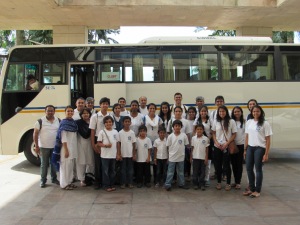
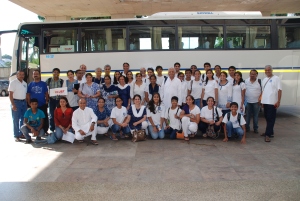



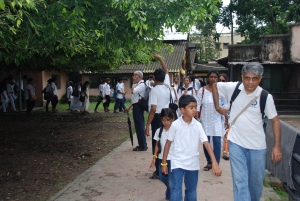






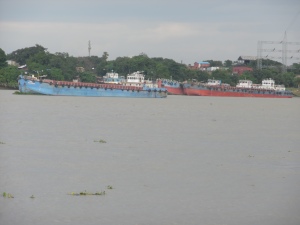
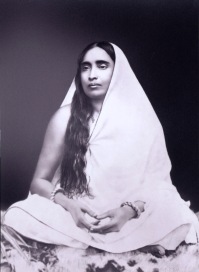












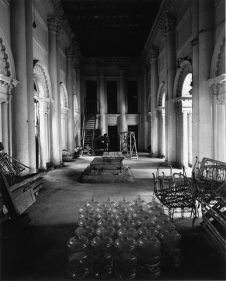

















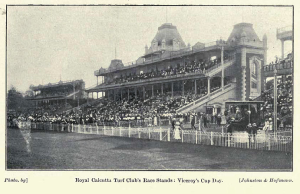

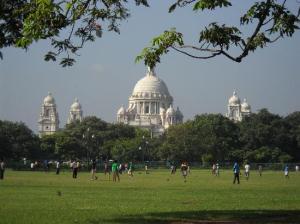















![The Town Hall [Calcutta] 1865](https://mahendrajani.files.wordpress.com/2016/08/the-town-hall-calcutta-1865.jpg?w=283&h=232)




































